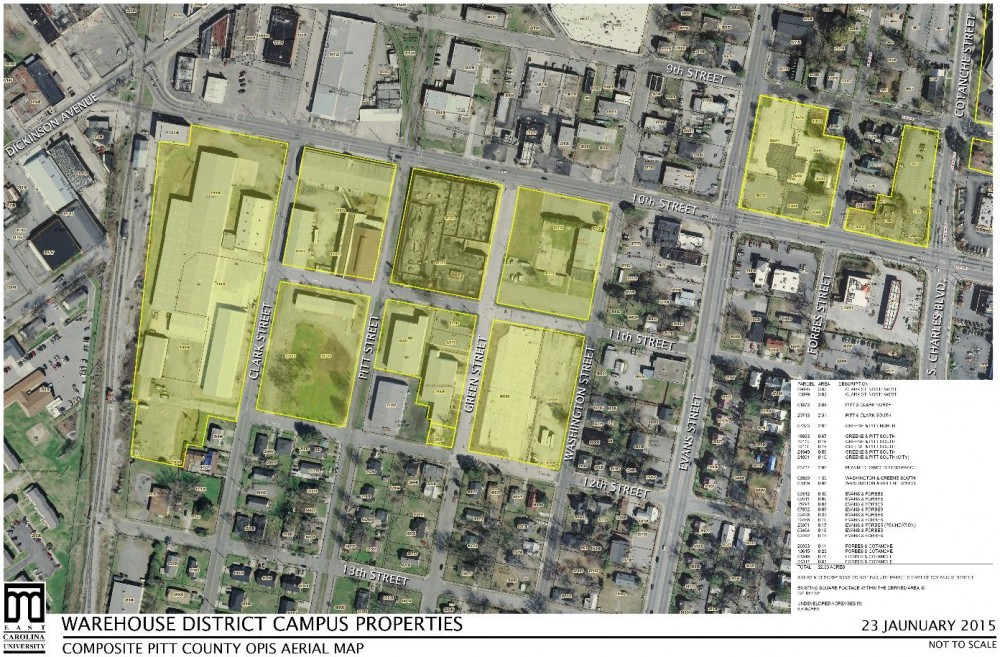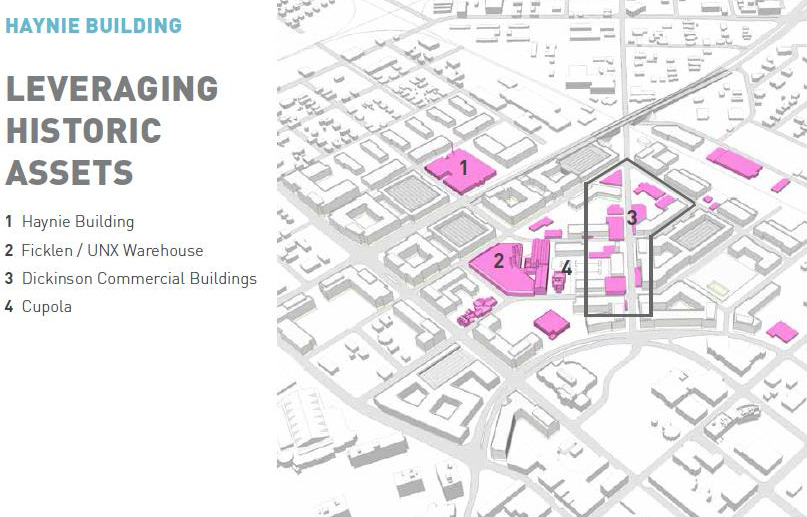Publisher's note: The author of this post, Steve Tuttle, is a contributor to ECU News Services.
Warehouse district eyed for ECU's millennial campus
East Carolina University is moving ahead with plans to rehabilitate a seven-block area in Greenville's warehouse district as a millennial campus — a site where the university can collaborate with private companies to commercialize research discoveries and offer advanced training to benefit the region's high-tech industries.
Officials said the project initially would focus on the Export Tobacco Leaf factory known as the Haynie Building. Built in 1914, it fronts 10th Street and covers the entire block between Pitt and Greene streets three blocks west of main campus.
The 22.3-acre site, which ECU acquired in 2003, also includes the American Tobacco Co. Storage Warehouse No. 2, which dates to the early 1900s, and the Prichard-Hughes Warehouse, built in 1905. All three buildings are listed on the National Register of Historic Places.
ECU has received eligibility certification to apply the N.C. Historic Mill Rehabilitation Tax Credit toward the cost of renovating the three buildings, according to Scott Buck, ECU associate vice chancellor for business services. Buck said those tax credits could defray 40 percent or more of the cost of the renovations.
Pictured upper left is a map of ECU's Warehouse District properties and at upper right is a map of downtown properties. Below is an aerial view showing the path of 10th Street Connector. Click on each map for a larger view. (Contributed images)
The ECU Board of Trustees voted Feb. 20 to ask UNC President Tom Ross to recommend that the UNC Board of Governor grant millennial campus designation to what has been named the East Carolina Research and Innovation Campus (ECRIC). The board is expected to discuss the request when it meets at ECU on April 8-10.
Millennial campuses are geographic areas where anchor institutions-usually research universities- join with education, industry, government, military and other partners to discover, invent and produce new innovations. Ted Morris, ECU associate vice chancellor for engagement, innovation and development, said such campuses deliver the training and expertise necessary to create new-economy businesses and jobs and connections to private investors to fund start-ups.
The sites often reclaim blighted urban areas, which then attracts mixed-use housing, offices and retail spaces.
Seven other UNC campuses already operate millennial campuses. The Centennial Campus at N.C. State University is the largest.
Under state law, the millennial campus designation will give ECU regulatory flexibility to finance repairs to the site and leeway to collaborate in business ventures with industry partners, Morris said. As a public institution supported by tax dollars, ECU normally would be precluded from such ventures.
The focus of the millennial campus will be on attracting, training and retaining skilled workers, many of whom will be ECU graduates. "These graduates are in high demand by regional employers and also help attract new employers to the region," Morris said.
Provost Ron Mitchelson emphasized that obtaining the required millennial campus designation for ECRIC isn't the first step in the process. He said it's the last.
Mitchelson said that under UNC system policies, millennial campus designation can only be granted to ECU after it demonstrates it has the administrative and fiscal capability to support such an undertaking. ECU also must show that the programmatic focus of the campus dovetails with its mission to serve the region by enhancing economic development and creating new jobs.
The ECU-Greenville Integrated Plan for an Arts and Innovation District is shown above. Click on the image for a larger view. (Contributed image)
Mitchelson said ECU has spent eight years getting ready to demonstrate it can meet those criteria.
In that time the university became even more closely engaged with civic and business leaders in the region to develop shared economic-development goals and to define ways ECU can help achieve those goals. The university then worked with those partners to create a portfolio of advanced training programs addressing those goals, Morris said.
The university has focused on partnerships with businesses in health care, advanced manufacturing (which includes pharmaceuticals), and the military, Morris said.
Chancellor Steve Ballard announced last November that ECU was creating a manufacturing center of excellence in partnership with three pharmaceutical companies that are major employers in the region — Patheon, Hospira and Mayne Pharma.
The center initially will operate out of the Sci-Tech Building under the direction of the chemistry department, Mitchelson said, and then move to the Haynie Building after it's been rehabbed.
Funding for ECRIC emerged on March 2 when the Golden LEAF Foundation awarded a $1.75 million grant to ECU and Pitt Community College to establish a biopharmaceutical work force development and manufacturing center.
The Haynie Building, where renovation could begin within a year, is highlighted with a #1 on the map.
In 2014 the foundation awarded ECU a $1.25 million grant to fund the Advanced Manufacturing and Innovation Academy, which immerses middle school students in careers and entrepreneurial opportunities in science, technology, engineering, arts/design and math.
ECU enjoys strong ties with pharmaceutical entrepreneurs in the region, notably Phil Hodges, an ECU graduate and former faculty member who in 1994 founded Metrics Inc., a contract pharmaceutical formulation and manufacturing company. He launched the company with the support of local angel investors. In 2013 Hodges sold Metrics to Mayne Pharma, an Australian concern, for $120 million.
Hodges now invests venture capital to commercialize additional ECU discoveries, Morris said.
When Durham-based Patheon acquired the Greenville operations of DSM Pharmaceuticals in 2014, Morris said ECU played a substantial role in persuading the company to locate a major expansion in Greenville. The expansion will create 488 new jobs and create the world's largest contract drug manufacturing organization. The state approved a $7.4 million economic development incentive package to seal the deal.
A North Carolina Department of Transportation graphic shows the planned 10th Street Connector bridge that will cross Dickinson Ave.
ECU's other partner in the advanced manufacturing center is Hospira, a manufacturer of injectable medicines and infusion technologies. It employs about 2,600 at its Rocky Mount facility. Hospira announced in 2012 that it would invest $275 million expanding the Rocky Mount plant and create 200 new jobs.
ECU has created training programs for IBM and other high-tech manufacturers. All such programs eventually will be housed in the warehouse district.
It's anticipated that ECRIC will lease space in the Haynie Building to one or more partner companies, angel investors and some business start-ups, Mitchelson said.
"We're excited to be placing some innovative programs in that space," Mitchelson said. "This is a place where pharmaceuticals, health care and engineering will all come together."
ECU already has demolished some structures in the warehouse district that were in poor condition and not historically significant, Buck said. More likely will fall, including the former Bostic-Sugg Furniture Co. building, he said.
The millennial campus property lies within Greenville's new arts and innovation district along Tenth Street and down the Dickinson Avenue corridor. The city is advancing several urban renewal programs to rehabilitate the district, which once was the heart of Greenville's tobacco and manufacturing economy.
A N.C. Historic Mill Rehabilitation Tax Credit would defray the cost of renovating buildings in the warehouse district for the millennial campus. (Photo by Cliff Hollis)
Some investment and changes already are occurring in the district and in uptown, and more is expected, city officials said.
All the buildings across 10th Street from the millennial campus site have been demolished to make way for the 10th Street Connector, a new roadway linking main campus with the medical campus about 1.3 miles away. The four-lane, divided roadway will become an attractive new gateway to the 10th Street side of main campus.
A main feature of the connector will be an elevated section crossing the railroad tracks at the intersection of 10th and Dickinson two blocks west of the Haynie Building. That will eliminate a major traffic bottleneck in the area.
After extensive landscaping and rehabilitation, officials hope the millennial campus and the city's arts and innovation district will blossom into a smaller-scale version of the American Tobacco Warehouse District in Durham.
Mitchelson pointed out that the warehouse district property has something that's in huge demand on campus-parking. The warehouses are surrounded by acres of paved lots, which will be a big advantage once tenants move in and active programs commence there, he said.
Mitchelson said rehabilitating the Haynie Building will begin with repairing or replacing the roof. He said that project should begin within a year. Rehabilitating the entire site will take years, Buck said.
Mitchelson said ECU would not know exactly how much it would cost to renovate the Haynie building until officials determine the specific needs of individual programs that will operate there.
In addition to the warehouse district property, ECU is asking the Board of Governors for millennial campus designation for three other parcels it owns. The other sites are:
- The university's uptown properties — 19 acres that lie on both sides of Reade Street from Fifth Street to First Street and the river front park.
- The Health Sciences Campus.
- The Stratford Arms and Blount Fields properties across Greenville Boulevard from Dowdy-Ficklen Stadium.
Morris said ECU will develop industry partnerships and training programs for businesses that fit the use of each of the three other sites. A program for advanced medical devices, for example, logically would locate on the Health Sciences Campus, Morris explained.

The Haynie Building in Greenville's historic warehouse district is pictured below. Built in 1914, it fronts Tenth Street and covers the entire block between Pitt and Green streets three blocks west of main campus. (Photo by Cliff Hollis)

Touring the Haynie Building, where renovations would begin for ECUís proposed millennial campus, are Ted Morris, left, ECU associate vice chancellor for engagement, innovation and development; and Scott Buck, associate vice chancellor for business services. (Photo by Cliff Hollis)































